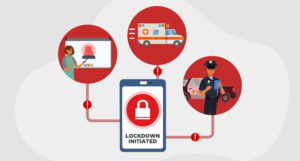Daycare and preschools prioritize safety and wellbeing while facing challenges unique to their environments. For example, daycares that operate within larger organizations—such as churches and community centers— may experience gaps in the ability to monitor visitors and contractors.
Protecting young learners and staff means implementing policies and procedures that close these gaps.
Adopting innovative strategies, particularly the integration of advanced technology, is key to monitoring, protecting, and ensuring a secure environment.
Supporting Safety Best Practices with Technology
Aligning best practices with advanced technology not only enhances physical security but also instills confidence among parents that their children are in safe hands. Leveraging technologies that aid in emergency preparedness and threat detection further demonstrates a culture where safety is prioritized.
Consider the following use cases:
1. Improve access control by checking visitors—including contractors—and volunteers against the sex offender database of all 50 states, as well as your own custom databases.
- Permit Safe Individuals on Campus: Consider technology adopted from highly secure industries, such as banking and finance, to verify identities and provide peace of mind.
- Screening Visitors: Tailor experiences based on visitor types, such as parents, contractors, staff, and volunteers.
2. Take volunteer management a step further by including required document submission and training completion in the application process—saving staff and volunteers time and stress.
- Online application: Customize and design your volunteer application. Streamline the entire process by automatically approving volunteers with no criminal or sex offender history and only reviewing applications with potential risk.
- Multi-level Screening: Automate volunteer background checks so the level of background check aligns with volunteer types or roles based on your requirements.
- Monthly Monitoring: Confirm volunteers continue to meet safety requirements with monthly monitoring of sex offender status and criminal background checks.
3, An emergency management system that integrates with your existing safety technology creates a safety ecosystem that streamlines your emergency response. For example, consider the impact of the following integrations:
- Student information system: Enables real-time insights and student accountability allowing informed decisions and swift emergency responses.
- Digital security systems and peripherals: Initiate multiple emergency response mechanisms—such as mass notification systems, public address systems, strobe lights, sirens, computers, and other alerting devices—from a single point, reducing the number of individual digital activations required during an emergency.
- Raptor Badge Alert: Raptor Badge Alert is a wearable alerting device that works seamlessly with the Raptor Emergency Management platform to help schools respond faster and more effectively. Integrated with your existing safety systems, it enables staff to instantly signal for help and share their exact location, without relying on Wi-Fi or cellular. Real-time data is automatically routed to administrators, dispatchers, and first responders, creating a connected safety ecosystem that strengthens communication and accelerates emergency response.
4. Dismissal management is critical at daycares and preschools where their pickup and drop off times vary greatly. And, at centers responsible for bussing students to and from other facilities, ensuring students are following the most up-to-date schedule.
- Centralize for Accuracy: Provide a centralized place where staff can coordinate dismissal procedures across various departure locations and options.
- Streamline Dismissal Changes: Parents can establish routines, make changes, and receive timely notifications, reducing frustration and logistical hurdles.
Let’s take a closer look at these use cases.
1. Know who is on campus
Ensuring a clear understanding of everyone on campus is a fundamental aspect of daycare security. Staff should attempt to limit the flow of traffic entering the school areas to a single-entry point. This will allow you to better scan who is entering the school campus—whether that’s in a standalone building or a shared site.
By integrating visitor management technology, daycares can establish a comprehensive system that meticulously verifies and tracks each individual’s entry and exit. This system includes:
- Instantly screening visitors against comprehensive databases, including sex offender registries across all 50 states, helps ensure that unauthorized visitors—or individuals with a concerning history—are flagged and addressed accordingly.
- Digital check-in/out procedures streamline the process and ensure approved guardianship. It also provides real-time tracking of who is on the premises, enhancing the ability to respond swiftly in case of an emergency.
- Customizable visitor badges let your school staff know that visitors are approved. Including role type, name, destination, date and time of entry, and photo on the badge makes it easy to determine that visitors are in the proper area of the school.
2. Grow—and streamline—volunteer programs
Growing volunteer programs through a blend of community engagement and technological oversight not only enhances the quality of care but also fortifies the security framework. Essential strategies include:
- Comprehensive Volunteer Screening: Build your criteria and requirements right into the application to receive the exact information you need to thoroughly review and approve each applicant. This could include requesting prospective volunteers to upload additional documents, like driver’s records, to stay in compliance with district and state mandates. Further streamline the entire process by automatically approving volunteers with no criminal or sex offender history and focus on reviewing applications with potential risk.
- Mandatory Training and Orientation: Offering mandatory training sessions on demand makes volunteering opportunities more accessible. When your criteria and requirements for volunteers are built into the system, you reduce the approval process from weeks to hours and can instantly notify approved applicants.
- Document Management and Compliance Tracking: Utilize digital systems to manage and track required documents and certifications for volunteers. This ensures that all necessary paperwork, including background checks, health clearances, and signed agreements, is up-to-date and readily accessible.
3. Streamline emergency response
An efficient emergency response is paramount in ensuring the safety of children during critical situations. Integrating technology to streamline these responses enables staff to act swiftly and effectively, minimizing risks and enhancing the coordination of safety measures. Key components include:
- Integrated Emergency Management Systems: Initiating lockdowns, activating mass notification systems, and interfacing with external emergency services become seamless and instantaneous when your safety ecosystem integrates with your emergency management system.
- Raptor Badge Alert: Merge the convenience of wearable technology with the strength of integrated software, simplifying emergency procedures and enabling schools to respond quickly to any situation. Multi-layered alerting and notification systems ensure critical information reaches the right people.
- Comprehensive Drill Management: Regularly scheduled drills for scenarios like fire, weather emergencies, or lockdowns ensure that both staff and children are well-practiced and prepared. This is particularly important for developing muscle memory for young learners. It also allows for the testing and refining of the technological systems in place.
- Streamlined, Efficient Reunification: Minimize trauma during emergencies by providing a structured process for swiftly reuniting students with parents or guardians. Efficient reunification software and workflows ensure a proper chain of custody, adhere to protocols, and reduce chaos.
4. Improve the dismissal process
A high level of traffic, changes in schedules and approved guardians, and young children entering and exiting the classrooms creates a chaotic dismissal process. Add in the higher degree of fluidity in the pickup and drop off schedules that preschools and daycares experience, and the ability to sufficiently manage the release of students is substantially limited.
Integrating dismissal software into school safety protocols provides daycares and preschools with tools to create a more efficient and less chaotic dismissal process. For example:
- Real-time information for parent pickup, a parent app that seamlessly integrates with student information systems for attendance and custody changes, and the ability to identify vehicles using license plates and QR tag, daycares can dismiss students safer, faster and more efficiently.
- Detailed school bus student ridership reporting allows you to maximize bus capacity, plan more efficient routes and manage tight budgets.
Improve safety and security with Raptor
Safeguarding young learners involves merging advanced technology with awareness of challenges unique to daycares to better address safety threats. Integrating robust visitor management and dismissal management technologies can help daycares improve the safety and security of their campus.
Learn more about integrated technology solutions for improving student safety with Raptor’s free guides.
Related Resources
GUIDE: THE ROLE OF IT STAFF IN MODERNIZING SCHOOL SAFETY
Considerations To Streamline Safety and Security Demands on School Technology Departments






